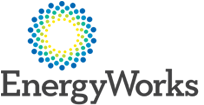 I bet you thought this day would never come. It is with great sadness that I announce that this is the last installment in the EnergyWorks series. But don’t shed that tear yet, Griddle readers. I am pleased to report that the energy efficiency work has been completed on my house, and I have already received my $300 rebate check in the mail.
I bet you thought this day would never come. It is with great sadness that I announce that this is the last installment in the EnergyWorks series. But don’t shed that tear yet, Griddle readers. I am pleased to report that the energy efficiency work has been completed on my house, and I have already received my $300 rebate check in the mail.
I am also happy to report that a few weeks ago I received a phone call from Andy Rachlin, who is with the EnergyWorks program. He informed me that the EnergyWorks program is offering a summer special on the initial home energy assessment. Instead of costing $400 up front with the potential for a $300 rebate, the price has been slashed to $150 with the potential for a $50 rebate through September 5th. Say it with me people, “I must sign up for this program today.” Seriously, $150 for a home energy assessment and the potential for a $50 rebate? I guarantee it’ll be the best $150 you’ll spend this summer.
Okay, end commercial–back to my own energy efficiency saga. If you recall, when I last left you, I was waiting to find out the verdict on whether or not the knob and tube wiring in my house could be removed so my attic could be insulated. Much to my chagrin, it turned out that removing the wiring from the attic was not that simple, and it would have essentially required rewiring three-quarters of my house and an extra $1,500. (It was already going to cost me about $1,500 to remediate the knob and tube if it was an “easy” job, so this would have brought the total expense for rewiring up to $3,000.) Unfortunately, because the EnergyWorks loan will not cover remediation work in excess of 25% of the overall project cost, that extra $1,500 would have been completely out of my pocket, and I just can’t afford that. So I’m sorry to say that my attic will remain uninsulated for the time being.
So, you may be asking yourself, what exactly did the Mark Group do to make my house more energy efficient?
Even without insulating the attic, there was a boatload of other energy efficiency work to be done on my house. The Mark Group had identified dozens of locations that needed to be air sealed. For the most part, they accomplished this air sealing work by using expandable foam in the big gaps and caulk in the small gaps. To give you a sample, they sealed all around the joists in the basement, the basement windows, the second floor bathroom skylight and the second floor lighting fixtures. They also wrapped my water heater in an insulating blanket, which makes me imagine that it’s all cozy down there in the basement. I want to make it a cup of tea to complete the picture.
The work they did was substantial, and when Zhenya Fomin came from the Energy Coordinating Agency to verify the quality of the work that Mark Group did on my house, the blower door test he ran came back with an air leakage rate of about 5000 cubic feet per minute (CFM) for my house. If you recall from Part 4 of this series, the air leakage rate was originally 6400 CFM. That’s about a 22% improvement. My house is still much leakier than a normal house (471 to 674 CFM), but Zhenya told me that he thinks I’ll be able to feel a difference in comfort with this improvement. I sure hope so. I may just be imagining things (or perhaps it’s wishful thinking), but it already seems like the second floor of my house isn’t getting as hot as last summer.
Essentially, the Mark Group took care of a lot of the big stuff, and now if I want to continue to air seal the smaller stuff, I can do it on an incremental basis with my trusty caulk gun. With air sealing, every little bit helps to reduce the stack effect that occurs in your home, so it’s worth sealing up air leaks as you notice them.
The last loose end to tie up is that I was able to qualify for the 0.99% loan for the work, and I opted for a five-year loan (other options included a three-year and 10-year loan). The total cost for the work ended up being $1,265.35, which will make my monthly payment on the loan $21.63. I’m hoping to make back a portion of that this winter when I don’t have to spend as much on heating oil, and at 0.99% it’s almost a free loan. And even though Zhenya told me that it would probably be six to eight weeks before I got my rebate check, it appeared in the mail within days of his verifying the work.
Overall, I have to say unequivocally that every homeowner in the Greater Philadelphia region should take advantage of this program. Not only is it an extremely worthwhile investment in your own comfort (both physically and monitarily), but it’s a great investment in the future of the Philadelphia area, both in terms of its housing stock and the growing job sector that’s needed to do this important work. Currently, only a few hundred Philadelphians have taken advantage of this great program. That means we have a long way to go before every house in the region is energy efficient. If you haven’t checked out the EnergyWorks program yet, what’s stopping you?






